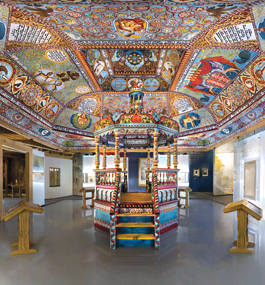Bringing Jewish History to Life at a New Warsaw Museum

M. Starowieyska, D. Golin/POLIN Museum
JEWEL IN THE CROWN: Five Brandeisians helped reconstruct the timber roof and polychrome wooden ceiling of the lost 18th-century Gwozdziec synagogue.
by Penny Schwartz, P’13
Last October, Poland’s new Jewish museum celebrated the opening of its permanent exhibition, with the help of a committed group of Brandeisians.
Located in what was once the heart of Jewish Warsaw — which became the Warsaw Ghetto during World War II — the POLIN Museum of the History of Polish Jews explores a rich chronicle, stretching from medieval times, when the Jews arrived as traveling merchants in the place they called “Po-lin,” up to today.
“We want to make sure that people don’t visit only Auschwitz and other death camps, but also understand that Jews had a 1,000-year history in Poland,” said Antony Polonsky, Brandeis’ Albert Abramson Professor of Holocaust Studies, at the opening celebration. Polonsky serves as the museum’s chief historian.
Other Brandeis community members played pivotal behind-the-scenes roles in launching the core exhibition. Along with students and scholars from around the world, five Brandeisians helped create the dazzling centerpiece of the museum’s permanent exhibition: a replica of the timber-frame roof and painted ceiling of the 18th-century Gwozdziec synagogue, which burned down during World War I.
Sarah Bierman and Jordan Pardo, both ’14, learned about the unusual project, led by Handshouse Studio, in an architectural drawing class taught by fine arts artist-in-residence Christopher Abrams. In 2012 and 2013, Bierman and Pardo participated in summer workshops in Poland, re-creating the historic wooden synagogue using traditional tools and methods.
Bierman helped decipher Talmudic prayers by studying photographs of the original calligraphic prayer panels painted on the synagogue’s ceiling and walls. Pardo found his niche mixing paints using a traditional hand-grinding method, an experience that put him more in touch with his Jewish heritage, he said.
Alexa Katz, Elisha Katz and Marissa Lazar, all ’14, also participated in the workshops.
Helise Lieberman ’79, director of the Taube Foundation’s Poland office, guided a delegation visiting the museum through Jewish Warsaw. Lieberman, who’s lived in Warsaw for the last 20 years, described the opening of the museum as a milestone in Jewish history. “It’s a privilege to watch a country and Jewish communities grow and find themselves in the Jewish world,” Lieberman said.
